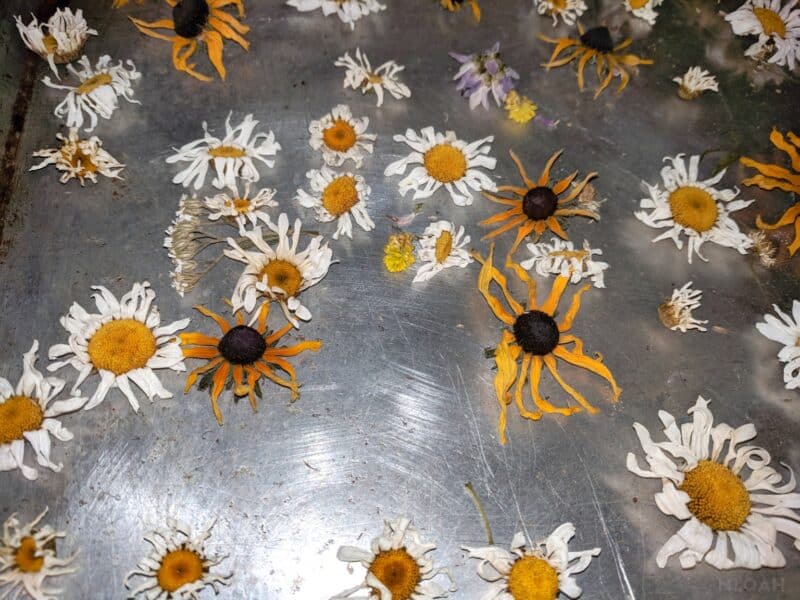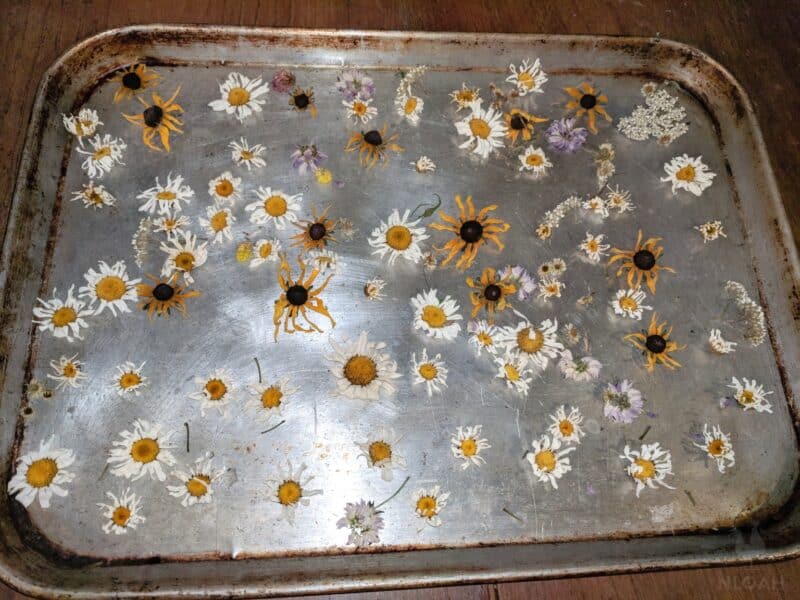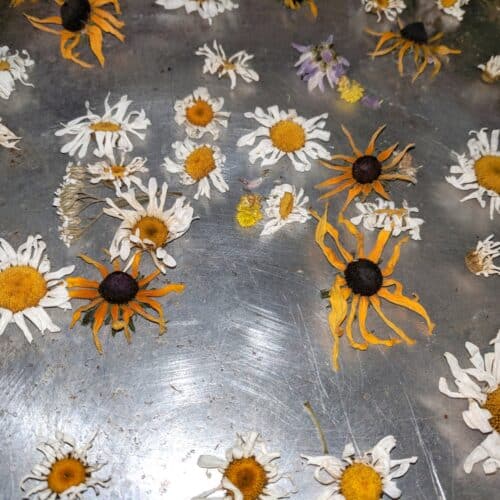Drying flowers to preserve them has been a homesteading tradition going back hundreds of years. The only downfall to the process is all of the patience it requires.
There are many reasons to dry flowers to preserve them. The dried flowers can be used in far more than just beautiful homemade wreaths and craft projects. You can preserve edible and medicinal flowers for use in a plethora of raw or cooked dishes, as well as in salves, tinctures, and healing pastes.

Pressing flowers between boards or sheets of cardboard takes weeks. These oven flower-drying techniques take only an hour or less. You can also dry them with a dehydrator – and it’s just as easy!
I am using the term “flowers” loosely here, fellow homesteaders. You can use the same flower preservation methods on “weeds” and leaves from flowers, bushes, and trees as well.
Harvesting Wild Flowers
Determining the best time to harvest wildflowers can vary depending on the species, especially when you are also going to preserve the leaves and – or stems, as well. Typically, you want to harvest the flower after it blooms, but not always.
The wild edibles recipe you are making or home remedy instructions should offer specifics about optimal harvesting time. It is entirely possible that stems and leaves may need to be harvested at different times than the blooming flowers that are produced on the same plant.
When preserving just the flowering portion of the plant, snip it just below the flower head so it will lay flat during the oven or microwave drying process. This helps ensure the even drying that is required for long-term preservation.
Selecting the Best Flowers for Drying
The most important step in preserving your blooms is selecting the right type of flower. Avoid using flowers with bruises or brown spots since these will not be preserved well. Always choose fresh flowers for the best results – pick them just before they have reached full bloom and after the morning dew has evaporated.
For thick flowers (like peonies, ranunculus, roses), you can remove petals before drying to make sure they last longer. Also, avoid using any type of flower with fleshy or water-rich petals since these may not preserve well.
Here are some types of flowers that work particularly well when it comes to drying:
- Sturdy blossoms: Small and sturdy blossoms like hydrangeas, amaranth, lavender, baby’s breath, celosia, and strawflower do particularly well when they are dried out because they tend to hold their shape better than other types of flowers.
- Flowers with multiple layers: Many multi-layered varieties like dahlias and zinnias also dry out nicely because each individual layer holds its own shape after drying out.
- Smaller or flatter flowers: Smaller varieties such as daisies or flat blossoms like carnations also look great when dried out since their smaller size makes it easier for them to retain their shape during the drying process.
- Larger flowers: Larger varieties such as sunflowers or chrysanthemums can also make excellent dried specimens if they are properly prepared before being hung up to dry!
How to Dry Flowers in the Oven
Equipment
- 1 Thorn stripper optional, but helpful for thorny plants like roses
- Drying rack optional but recommended to increase air flow if drying thick or large flowers.
Ingredients
- Flower heads
- Baking Sheet
Instructions
- Set oven on the lowest setting available. A heat setting ranging from 150F (65C) to no more than 200 °F (93 °C) degrees is highly recommended. If you're using a convection oven, aim for 175 °F (80 °C) if possible.
- Prepare the flowers, removing excess foliage and trimming off any stems. Get rid of any thorns and cut the stems to the desired length.
- Place all of the flower heads onto the baking sheet, spreading them out so they do not touch. If using baking racks, place them onto the baking sheet first, and then fill them with the flower heads.
- Set the time for at least 1 hour, but up to 1.5 hours if preserving a lot of flowers on multiple trays. It may take up to 2 hours to dry the flower heads if they're large or thick.
- Check on the flowers about every 30 minutes to avoid over-drying them and causing scorching. You'll know they're done if they're dry and crispy to the touch – if they're wet or tacky at all, they aren't done yet – put them back in.
- Remove the flowers from the oven, and allow them to air dry to room temperature before storing in a container with an airtight lid.
Notes
Storing Your Dried Flowers
When selecting your flowers for storage, choose ones that are in good condition before the drying process even begins. Wilted, bruised, or damaged ones won’t last as long after drying. If you want vibrant colors in your dried arrangements, select fresh blooms that are at their peak.
Light and heat can cause fading in color, so it’s important to keep your dried flowers out of direct sunlight to prevent them from losing brightness over time. Place them away from any windows or bright lights that could damage the delicate petals and fade away the colors of your beautiful arrangement.

If you can, store your flowers in an airtight container (ideally one made out of glass) in a dark, cool location.
To preserve their shape and prevent petal loss, spray unscented hairspray on them once they’re dried and arranged as desired.
This will help hold them together for longer-lasting beauty. Just be sure not to get too close when spraying, or you could end up damaging the delicate petals. Keep an even distance when spraying, and use light strokes for the best results.
How to Use Dried Flowers
Dried flowers are a great way to add color, texture, and natural beauty to your home.
There are so many creative ways to use dried flowers, from wreaths and garlands for your walls to potpourri for scent and sachets for gifts. Not only that, but you can also use them to make dyes, candles, and even cleaning products!
One of the most popular uses for dried flowers is making bouquets. You can create a beautiful arrangement that will last much longer than a fresh flower bouquet.
Another great way to use dried flowers is to make wreaths for your walls. This project is especially great if you have an abundance of various types of dried flowers in different colors and textures as it allows you to really get creative with the design!
Oven Flower-Drying FAQ
To keep the color of your dried flowers vibrant, you will need to set your oven even lower – around 150°F (or 65°C). The petals may require a few minutes longer in the oven at this temperature but it will be worth it when you see the amazing results!
The key to drying flowers quickly is using low heat and setting the oven timer. Most ovens have a low setting that goes down to 200°F (or 93°C).
To dry flowers in a flat oven without risking burning them, place them directly onto the wire rack of your preheated oven at 200°F (93°C). Make sure they are evenly spaced out so that air can circulate around them while they bake.
The ideal temperature for drying flower petals in an oven is around 150 to 200 degrees Fahrenheit. If your oven doesn’t get this low, that’s okay, but be sure to check them often.

Tara lives on a 56 acres farm in the Appalachian Mountains, where she faces homesteading and farming challenges every single day, raising chickens, goats, horses, and tons of vegetables. She’s an expert in all sorts of homesteading skills such as hide tanning, doll making, tree tapping, and many more.

